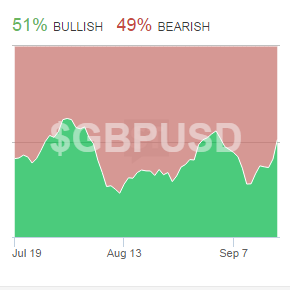As Scotland prepares for tomorrow’s Independence Referendum vote, polls are currently too close to call. For traders, the lack of clarity of how things will play out tomorrow has led to both short and long-term speculation taking place on the direction of the British pound (GBP). Specifically, up for debate is how affected will GBP supply and demand be.
On one hand, Scotland could decide to continue using the pound as its currency. But, even in that scenario, taxation shifting and state owned revenues transferred to Scotland would be expected to disrupt the UK’s economy and lead to an overhaul of adjusting government budgets. An independent Scotland could ultimately decide to file for EU membership and adopting the euro, which would mean a long-term rotation away from the pound, adding supply to the market.
While the Forex market isn’t showing a thoroughly one-sided opinion on the voting, traders are favoring to short the pound going into tomorrow’s referendum. The short bias exists, even as the GBP/USD has already fallen over 5% from its year highs set in mid-July to a current 1.6331.

For brokers and exchanges, pound speculation has been a boon for volumes, extending increased Volatility and trading that took place in August and peaked in early September following further monetary easing from the ECB. The ongoing active markets contrasts from the first seven months of the year, when spikes in volatility tended to fizzle out within a day or two.
In connection to the referendum, the CME announced today that Open Interest in GBP options hit a record of 168,773 contracts on September 8th, but have since fallen to 143,310 contracts. At the time of the record, puts composed of 60% of open interest but has since retreated to 56%. The September 8th record coincided with 10 month lows in the GBP/USD at 1.6050 which may have indicated that some traders were expecting pound weakness due to the referendum,and may have closed positions after realizing profits well before voting took place.
Interestingly, the 56% put rate mimics that of traders at Saxo Bank, where figures from the broker indicate a 56%/44% Short/Long ratio for their traders. In a report today, Nick Beecroft, Senior Market Analyst at Saxo Bank, commented about the current weakness in the GBP/USD, a potential buying opportunity if voting was against Scottish independence, stating, “If the NO vote succeeds, GBP could start the long march back up towards the 1.6500 area and perhaps higher. Sterling’s current valuations would start to look rather under-valued underpinned by the recent indications from Bank of England Governor, Mark Carney that UK interest rates could rise as soon as the spring of 2015.”

StockTwits GBPUSD Sentiment
Among other retail clients, the GBP/USD bearishness was more severe at eToro, where short positions are currently at 64%. Interestingly though, sentiment analysis at other social sites, but which aren’t directly calculated using customer positions, showed nearly no short bias. At StockTwits, sentiment among users has swung to 51% bullish today from only 27% earlier in the month. StockTwits uses a 7-day rolling average to calculate its sentiment, which may mean that current one day bullishness has risen well above the 50% mark with traders expecting a sharp spike higher tomorrow. Elsewhere, Investing.com sentiment is also only slightly bearish with a 52% mark.
Overall, the GBP/USD’s recent bounce from its 10 month low appears to have removed the sharp short conviction that existed in the markets early last week. As such, a ‘NO’ vote would be expected to trigger a reactionary pop higher in the GBP/USD, but without a sharp bearish bias, we may not see much of a short squeeze take place. On the other hand, a vote of ‘Independence’ could lead traders who are currently on the sidelines, but were riding the GBP/USD lower to reenter their trades on speculation of a retest of September’s lows. Either way, brokers and exchanges win regardless of the results of the voting.

















